Sound Souvenirs: Music Out Of The Moon
aug. 01, 2009.
One of the interesting aspects of the fifteen year old story that I wrote up in the previous entries of the SoundBlog, is that regularly Eloise, though just in passing, voices her intimate relationship with a small piece of technology: her walkman. "My job is to walk around Athens with my walkman on, listening to nice music and finding things that would be interesting for the show," Eloise tells her Abelard. And, after having addressed her absent lover late at night, while listening to music in the background, she tells him that she doesn't "want to stop the music, so I'm gonna put my walkman on. I'm going to sleep with my walkman on". And again, some time later, she recounts Abelard how after having spent time at her sister's flat, she "walked from her house to my house. With my walkman on. Looking the night and feeling quite happy" ...
Given the fact that she used the same walkman (or a similar cassette-recorder), to put her monologues on tape, the story is itself expression and result of this special (wo)man-technology relation. Which indeed is an intimate one. Microphone and tape became a substitute for Abelard, to such extend that at some point we hear Eloise say that she was "thinking of calling you [...] But at the other hand, I said, eh, first I should talk to him on the mike" ...
The making of voice letters, like the one that Eloise recorded and then
sent to her Dutch lover (as the finding of the tape 15 years later in a street in Amsterdam suggests), is among the several 'creative' uses of magnetic
tape that were extensively promoted by manufacturers of tape and
tape recorders 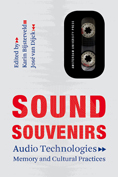 in
the early days of the introduction of the medium to the general public.
The industry thus attempted to position the tape machine within
the western households of the 1950s and 1960s as a thing with a
functionality distinct from that of a mere passive music playback device,
like the gramophone or the radio. In the opening chapter of Sound Souvenirs
(a collection of articles around the themes of audio technologies, memory
and cultural practices,
recently published by Amsterdam University Press), Karin Bijsterveld and
Annelies Jacobs describe how this calculated attempt to entice mid-20th
century consumers via marketing to take up en masse the recording,
sharing and archiving of their daily soundscapes, failed. As an earlier,
related article of Bijsterveld's ( * ), also this
one comes richly illustrated with a selection of advertisement photographs
from those years, that all by themselves already tell much of the story,
and which are as amusing as they are revealing.
in
the early days of the introduction of the medium to the general public.
The industry thus attempted to position the tape machine within
the western households of the 1950s and 1960s as a thing with a
functionality distinct from that of a mere passive music playback device,
like the gramophone or the radio. In the opening chapter of Sound Souvenirs
(a collection of articles around the themes of audio technologies, memory
and cultural practices,
recently published by Amsterdam University Press), Karin Bijsterveld and
Annelies Jacobs describe how this calculated attempt to entice mid-20th
century consumers via marketing to take up en masse the recording,
sharing and archiving of their daily soundscapes, failed. As an earlier,
related article of Bijsterveld's ( * ), also this
one comes richly illustrated with a selection of advertisement photographs
from those years, that all by themselves already tell much of the story,
and which are as amusing as they are revealing.
Have a look, for example, at
the following photograph from a 1960 BASF advertisement:
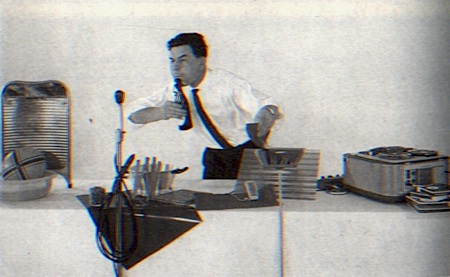
Except for the unusual dress-code, but including all of the equipment, this is the kind of scene that
nowadays one typically might encounter as part of one or another among current sound art practices.
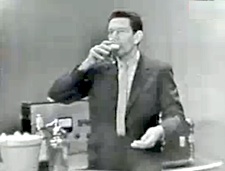 As such
it also strongly reminds one of John Cage's hilarious and impeccably timed performance
of Waterwalk on the American TV show I've Got a Secret, that most
viewers probably will know (e.g. from YouTube's), and
that is from 1960 as well.
As such
it also strongly reminds one of John Cage's hilarious and impeccably timed performance
of Waterwalk on the American TV show I've Got a Secret, that most
viewers probably will know (e.g. from YouTube's), and
that is from 1960 as well.
"[A]dvertisements portrayed men
as creators of sound effects," Bijsterveld and Jacobs observe, "such as for radio plays."
All of these marketing efforts notwithstanding, the industry did not succeed
in getting a substantial part of western males to become after-hours foley
workers and sound artists avant-la-lettre, while the females
in day-time recorded their offspring's early linguistic utterances, and
spoke voice letters to the cousins et cousines that had moved to
some place far-away. The average consumer's creative potential and his/her
willingness to, besides money, also invest time and energy in the mastering
of machinery that was cumbersome to handle and not easy to learn to use
properly, were clearly over-estimated. With the exception of but small groups
of enthusiast hobbyists (like the 'sound hunters', precursors to
our fieldrecorders and phonographers), if at all, the household tapes and
tape machines, contrary to the manufacturers original intentions, were mostly
used for the archiving and consumption of recorded music.
On the other hand, though again a relatively small group, one should also not under-estimate the number (and maybe even less so: the quality) of the individuals that were not so much inclined to the pursuit of a sonic equivalent of bird watching, but for which the creative applications of magnetic tape and tape recorders, becoming readily available also to non-academics and non-professionals, nevertheless were nothing short of a revelation. Many of them became initiators and propagators of intriguing and influential (sub-)cultural movements, like, for example, that of DIY in music and the arts in general. But that is yet another story. One that might have been, but is not, covered in the present collection, edited by Karin Bijsterveld and José van Dijck.
Sound Souvenirs is the result of a collaboration started in 2003 between media scholars of the universities of Amsterdam and Maastricht. An earlier offspring was the Sound Souvenirs symposium that took place in Maastricht in november 2006, and which, like the present book, aimed at investigating and mapping out the ways in which audio technologies are used to "elicit, reconstruct, celebrate and manage our memories".
The 12, but loosely related, articles that comprise Sound Souvenirs are divided into 4 main subject groups (Storing Sound, Auditory Nostalgia, Technostalgia and Earwitnessing). They take the reader on a colorful tour of sound-culture phenomena as divers as - to name about half of them - mix tapes (Bas Jansen), the rise and development of mobile music listening in post-war Germany (Heike Weber), the personal auditory nostalgia practiced by iPod users (Michael Bull), doo-wop concerts in New Jersey (Timothy Taylor), the use of vintage gear and instruments by (pop) musicians (Trevor Pinch and David Reinecke) and the revival of the Theremin (Hans-Joachim Braun).
Sound Souvenirs is not a book of big theories. Though some of
the authors (some more, some less) designate or hint at theoretical frameworks
or even grander schemes, most of the papers employ an anecdotal
approach of their subject via a descriptive analysis of a series of well
chosen examples. It therefore are most of all the sometimes surprising facts
and the wealth of examples that make Sound Souvenirs a worthwhile
read, despite an uneven and occasionally pretty awkward (fun-)academic
style of discourse, that here and there manages to stop and hit
one with a conclusion at the end of what until then seemed to be
merely part of the introduction. But if nothing else, the book
does convincingly illustrate the intricate and multifaceted connection that
exist between sound/music and memory and its management.
They are curious beasts, indeed.
Going through the book's twelve
chapters one after the other, evoked a parallel series
of personal memories, anecdotes, reflections and examples, and I cannot but thank the authors for this.
Thus it was a combination of the articles in Sound
Souvenirs dealing with the transistor radio and the recent celebration of the fact
that forty years ago man
first set foot on the moon, that managed to 'take me back' to the summer of 1969, and
our own family's portable radio receiver. Would you ask me what brand it was, I will immediately retort Aristona.
And were I to describe it, I'd say it came in very vivid colors, like a flashy red and a bright yellow; and
that it had a transparent, big circular
disc that one used for its tuning.
All of this may very well be, eh ... false, though. But such were my immediate associations ... (that often
are mistaken for 'memories', but are in fact far more complex constructs).
Curiously, I have no recall whatsoever of music playing
through this mid-sized rectangular plastic box, but I do remember how especially my father moved it around a lot, to
be able to continue to listen to reportages. Which mainly
meant: football matches or politics.
Or space travel.
While Apollo
11 set out on its journey to the moon, we spent the yearly summer holidays
at the Dutch coast. There, in one of the many summer holiday camping places,
my parents had rented a small wooden cabin, where the four of us resided
for a week or two, doing our best to catch a sun burn by exposing ourselves
at the north sea beach that we faithfully went to early each morning, and
returned from late in the afternoon. Of course we took the transistor, and
day after day, on and off the beach, we followed NASA's
lunar mission as it was aired onto our little radio by the Dutch public
broadcast. 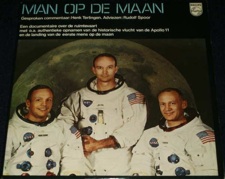 Together we earwitnessed the Eagle's landing (which, in Dutch time, occurred
some 15 minutes over nine in the evening of sunday july 20th), and I was
very eager not to miss one single sound bite also of Neil
Armstrong's first step onto the moon's surface. This was to take place
a then but very approximately known number of hours later. Meanwhile, nothing
much spectacular or even interesting for earthly listeners was happening
over at Tranquility
base. My father gave me permission to take the transistor up with me
into the bunk bed, stowed into the cupboard size space where my brother
and I were sleeping. There was a tiny square window through which every
so many seconds the light of a lighthouse came falling. Could we maybe even
have looked out up into a cloudless sky and see the moon? It's
one of the so many small but significant details that I wished I could remember,
but I don't ...
Together we earwitnessed the Eagle's landing (which, in Dutch time, occurred
some 15 minutes over nine in the evening of sunday july 20th), and I was
very eager not to miss one single sound bite also of Neil
Armstrong's first step onto the moon's surface. This was to take place
a then but very approximately known number of hours later. Meanwhile, nothing
much spectacular or even interesting for earthly listeners was happening
over at Tranquility
base. My father gave me permission to take the transistor up with me
into the bunk bed, stowed into the cupboard size space where my brother
and I were sleeping. There was a tiny square window through which every
so many seconds the light of a lighthouse came falling. Could we maybe even
have looked out up into a cloudless sky and see the moon? It's
one of the so many small but significant details that I wished I could remember,
but I don't ...
So this is where and how I was at a moment in time that
part of the collective
memory of at least two successive generations was written: all greasy and smelling of mosquito oil
that mother smeared all over our faces and limbs to repel the buzzing
blood suckers, listening to the babblings of mission control in Houston and
of the Dutch commenters in Hilversum that filled up the long hours
before Neil Armstrong stepped down the Eagle's ladder and set foot in the moon's dust.
When
he finally did though, it is sad but true, I was fast asleep.
I dozed off long before mankind's giant leap, only to wake again several
hours after, to the softish noise of a de-tuned transistor and the busy
tweeting of the many birds outside.
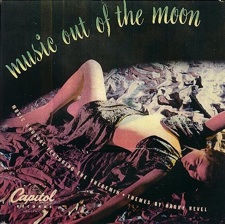 This
is how one sound souvenir unavoidably leads to another: we read
on page 174 of David M. Harland's The
First Men on the Moon
This
is how one sound souvenir unavoidably leads to another: we read
on page 174 of David M. Harland's The
First Men on the Moon,
that the Apollo 11 crew "had a cassette player with a variety of music tapes"
and the astronauts "had their supper to the accompaniment of music". The
music that Neil Armstrong took with him is typical for the man so very wary
of publicity and who, even after forty years now, continues to refuse to
express himself on 'how it was' to be out and up there. Like many of his
choices and expressions at the time, also the mission commander's pick of
music comes with that little touch of drama and surplus in meaning,
indeed, as if it had been scripted. Armstrong brought Dvorák's
New World Symphony, and Broadway composer Harry Revel's Music
Out Of The Moon. The latter probably will be less known than the former.
It is a collection of 6 quite remarkable 'spage age easy-listening' tracks,
originally released in 1947 as a triple set of 10" 78rpm records, conducted
by Leslie Baxter and - most notably - featuring the virtuoso Samuel
Hoffman playing the Theremin: an eerie singing saw in the midst
of Baxter's utterly optimistic sounding soft-jazz orchestra and the cheesy
wall-to-wall wide vocables ('Ahh, oeehhh, a-a-ahhh, doeh-doeh, oe-oeh')
of the choir. Together they make for an everything's-as-right-as-rain sort
of feel that is a neat sonic reflection of the visual quality of, for example,
the advert-photographs that illustrate Karin Bijsterveld's articles on the
early uses and domestication of the tape recorder ... There is an extensive
- and also in itself somewhat curious - analysis of Moon Moods,
one of the 6 Music Out Of The Moon tracks, in Strange
Sounds
,
a monograph on music, technology and culture from 2001 by Timothy Taylor
(the author of the 'doo-wop' article that is part of Sound Souvenirs collection).
Sound Souvenirs are omnipresent indeed, and they relate to pretty much anything. Once one starts thinking about them, one will find striking illustrations of many of the themes addressed in the Bijsterveld-van Dijck collection in every one of the manifold of private and public events that make up our lifetimes. But, as Jonathan Sterne convincingly argues in his contribution 'The Preservation Paradox in Digital Audio', most of these 'souvenirs' will eventually have to perish along with the very generations that created, beheld and cherished them ( ** ) in order for some of them to live on in a meaningful manner. Next generations by and by will collectively forget the collective memories that constitute much of the essence of the present one, and which slowly will fade into oblivion. How could it be otherwise? Thus almost all of our 'recordings' in the end will be 'lost recordings', but the disappearance of individually backed up and stored souvenirs has never been as potentially relentless as it is in our digital age. (As I once somewhat over-dramatically put it: "A fully digitalized culture is one able to disappear without leaving a trace.")
I think that is a relief.
[ Sound Souvenirs - Audio Technologies, Memory and Cultural Practices. Edited by Karin Bijsterveld and José van Dijck. Amsterdam University Press, 2009. 218pp. ]
...
notes __ ::
(*) Karin Bijsterveld - ‘What Do I Do with My
Tape Recorder …?’: sound hunting and the sounds of everyday Dutch life in
the 1950s and 1960s. Historical Journal of Film, Radio and Television
Vol. 24, No. 4 (2004) [ download
pdf ] [ ^ ]
(**) See also my
earlier report on projects attempting to preserve rapidly aging media
artworks, doomed to disappear because of the degradation of their physical
supports, or the becoming obsolete of their digital formats. [
^ ]
tags: Sound souvenirs, moon, Apollo 11, 1969
# .325.
smub.it | del.icio.us | Digg it! | reddit | StumbleUpon
comments for Sound Souvenirs: Music Out Of The Moon [iii] ::
|
Comments are disabled |